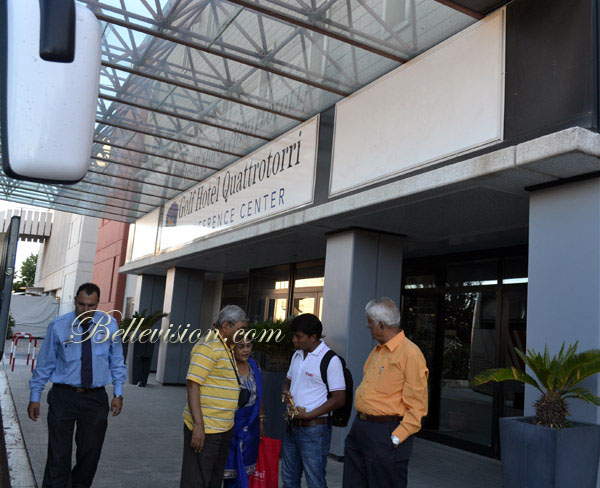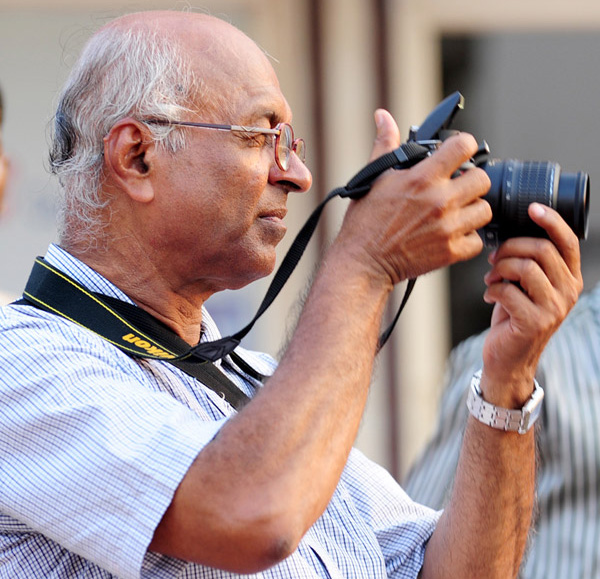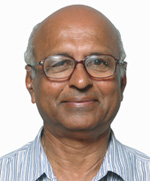Wonders of Europe-10: The Eternal City of Rome-Journey through Roman History and Holy Vatican City
By Dr. Eugene DSouza, Moodubelle
Bellevision Media Network
Udupi, 29 Oct 2013: Waking up early in the morning and looking forward for an exciting journey through the eternal city of Rome regarded as one of the world’s most beautiful ancient cities that contains vast amounts of priceless works of art palaces, museums, parks , churches, gardens, basilicas, temples, villas, piazzas, theatres, and other spots of tourist interest we packed our belongings, had a sumptuous breakfast and boarded the bus and headed towards Rome. We covered 136 kilometers of journey from Perugia where we had halted for the night to Rome in around two and half hours.
As we entered the city of Rome, I had a strange feeling of being in a place which was once the centre of the vast Roman Empire that extended over three continents and the seat of the Roman Catholic Christianity. As we proceeded towards the magnificent Colosseum, I could sense the remains of ancient Roman civilization mingling with modern structures.
The bus halted on a hillock overlooking the Colosseum from where we had to walk for a distance and descend to the location of the ancient amphitheatre. I had seen the pictures of the Colosseum in a number of English movies such as ‘Roman Holiday’ and ‘Gladiators’ and had read about the persecution of early Christians in the Colosseum. However, personally seeing the ancient structure of tremendous historical importance was quite exciting.
The Roman Colosseum or Coliseum, originally known as the Flavian Amphitheatre, was commissioned in 72 AD by Emperor Vespasian on the site of Nero’s palace to dissociate himself from the hated tyrant. It was completed by his son and heir, Titus, in 80 AD. Further modifications were made during the reign of Domitian. These three emperors are known as the Flavian dynasty, and the amphitheatre was named in Latin for its association with their family name (Flavius).
The Colosseum is located just east of the Roman Forum and was built to a practical design, with its 80 arched entrances allowing easy access to 55,000 spectators, who were seated according to rank. The Colosseum is huge, an ellipse 188meters long and 156 meters wide. Built of concrete and stone, it was the largest amphitheatre of the Roman Empire, and is considered one of the greatest works of Roman architecture and engineering. When it was constructed, the aim of Emperor Vespasian was to gain popularity by staging deadly combats of gladiators and wild animal fights for public viewing. It is said that at the inaugural games in 80 AD, over 9,000 wild animals were killed.
Although in the 21st century, the Colosseum stands partially ruined because of damage caused by devastating earthquakes and stone-robbers, the Colosseum is an iconic symbol of Imperial Rome. It is one of Rome’s most popular tourist attractions and has close connections with the Roman Catholic Church as each Good Friday the Pope leads a torch lit "Way of the Cross" procession that starts in the area around the Colosseum.

.jpg)
.jpg)
.jpg)
.jpg)
.jpg)
.jpg)
.jpg)
Roman Forum
.jpg)
.jpg)
Colosseum
.jpg)
.jpg)
.jpg)
.jpg)
.jpg)
Arch of Constantine
.jpg)
.jpg)
.jpg)
.jpg)
.jpg)
.jpg)
.jpg)
.jpg)
.jpg)
.jpg)
.jpg)
.jpg)
.jpg)
Palatine Hill
.jpg)
.jpg)
.jpg)
.jpg)
Right next to the Colosseum stands the Arch of Constantine, the most recent of the three remaining imperial triumphal arches in Rome (the other ones are the nearby Arch of Titus and Arch of Septimius Severus). After years of civil war, the victory of Constantine’s army over the numerically superior army of Maxentius at the Battle of Milvian Bridge in 312 AD brought some peace to the Roman Empire.
The Arch of Constantine rises almost 70 feet high, is more than 85 feet wide, and is almost 25 feet deep. The surface of the arch has detailed carvings and bas reliefs including a scene depicting the actual Battle of Milvian Bridge. There is even a carving depicting Constantine’s departure for Milvian Bridge from the seaport of Milan. Four superb Corinthian columns made of yellowish marble from Morocco and Tunisia in North Africa adorn each side of the arch. When we visited the site, we could see scaffold being raised for maintenance work.
Near the Colosseum, on the other side of the road we could see the ruins of the Roman Forum which was the central area of the city around which ancient Rome developed. Here was where commerce, business, cult and the administration of justice took place. The Roman Forum was designed by the architect Vitruvius. For centuries it was the site of the city’s most important public buildings. The Roman Forum became the spectacular showcase of the Roman Empire filled with beautiful statues and architecture.
Located in between such attractions as the Circus Maximus, the Colosseum, and the Roman Forum is the Palatine Hill whose past pre-dates the city itself and it holds an important place in the history of the Eternal City. Palatine Hill is the centermost of the famous Seven Hills of Rome., evidence from archaeological digs demonstrates that the hill was inhabited as long ago as the 10th century BC. Today the hill looks like a heap of ruins, but during the Imperial era, the hill was completely built up with large palaces and other buildings.
The Palatine Hill has a strong link to Roman mythology. It is believed that on this hill, the twins Romulus and Remus were found in the Lupercal Cave by their four-legged shepherd mother, who raised them. Ultimately, this is where Romulus decided to build the city. Therefore, it was on this hill that the Roman Empire began.
After spending considerable time viewing and clicking the pictures of the Colosseum, Arch of Constantine, Roman Forum and ruins on some parts of the Palatine Hill, we proceeded towards Vatican. On the way, just across the bridge, by the side of the Tiber River, the guide pointed towards a towering cylindrical building known as the Mausoleum of Hadrian, usually known as Castel Sant’Angelo, meaning Castle of the Holy Angel. It was initially commissioned by the Roman Emperor Hadrian as a mausoleum for himself and his family. The building was later used by the popes as a fortress and castle since the beginning of 14th century. Pope Nicholas III connected the castle to St Peter’s Basilica by a covered fortified corridor. The fortress was the refuge of Pope Clement VII from the siege of Charles de Bourbon’s army during the sack of Rome in 1527.
.jpg)
Castle of the Holy Angel
.jpg)
.jpg)
At the top of the fortress, overlooking the panoramic terrace stands a statue of an angel, built by the 18th century Flemish sculptor Pieter Verschaffelt. The bronze statue replaced an earlier, marble version. The statue depicts the Archangel Michael who, according to legend, appeared on top of the fortress in the year 590 and miraculously ended the severe plague that had infested the city of Rome. After the purported event, the building was renamed as Castel Sant’Angelo - literally translated ’Saint Angel Castle’ - in honor of Michael the Archangel.
After crossing the bridge and moving further, I could see the mighty dome of St. Peter’s Basilica rising above the complex known as St. Peter’s Square and I could capture the pictures of the entire structure as the bus took a turn towards the restaurant where we had lunch before undertaking the tour of the Vatican City, the most cherished part of our Wonders of Europe Tour.
Alighting near the Vatican walled enclosure we entered the complex through a huge arched gate and were in the open space with grass lawns hemmed with buildings for different purposes. After walking for quite a distance and climbing staircases we arrived at the Beledere Courtyard where the Vatican Museum Complex is situated.
.jpg)
St. Peter’s Basilica
.jpg)
.jpg)
.jpg)
The Vatican Museums were founded under the patronage of two 18th century popes - Clement XIV (1769-1774) and Pius VI (1775-1799) - who were among the first to open collections of art to the general public for viewing, therefore promoting culture among the masses. The first building in the museum complex, the Pio-Clementine Museum was named after these two pontiffs.
With the passage of time more popes added to the already impressive collection of diverse artworks owned and displayed by the Vatican. Presently, there are 13 museums in about 14 Vatican palaces that are included on tours of the Vatican Museum complex. The building complex is worth a visit in itself as all rooms and hallways are lavishly decorated with marble and frescoes.
.jpg)
Main Entrance of the Vatican City
.jpg)
Vatican Museum Courtyard
.jpg)
Belvedere Courtyard
.jpg)
Statue of Apollo
.jpg)
Statue of Laocoon
.jpg)
Statue of Neptune
.jpg)
Display of Animal Statues in Vatican Museum
.jpg)
.jpg)
.jpg)
.jpg)
.jpg)
.jpg)
.jpg)
.jpg)
.jpg)
.jpg)
.jpg)
.jpg)
.jpg)
.jpg)
.jpg)
.jpg)
.jpg)
.jpg)
.jpg)
It is not possible within the given period of time to visit all the museums nor is it possible to view and understand the significance of various artifacts in one museum. We had to rush through some of the important museums. I could click pictures of some of the most interesting artifacts such as marble statues depicting Greek and Roman mythology and heads of various animals as we rushed through some of these museums.
On the way to the Sistine Chapel, we could see carpet like tapestries with themes from the life of Christ and other religious subjects on both sides of the corridor leading to the Sistine Chapel.
One of the highlights of the Vatican Museums is the famous Sistine Chapel, where visitors can enjoy not only Michelangelo’s paintings on the magnificent ceiling but also a host of other wonderful works of art, including the Last Judgment on the altar wall by the same artist. It is said that while paining the face of Jesus in the Last Judgement scene, Michelangelo was inspired by the face of the statue of Apollo, the famous Greek deity which is placed in one of the Vatican Museums. The ceiling painting, which depicts scenes from the Old Testament, including the Creation of Adam is one of the world’s most famous works of art. Most of the frescos in the Sistine Chapel were painted by Michelangelo. As photography was not permitted within the Sistine Chapel, no pictures could be clicked of the magnificent frescos inside the chapel. However, to give an idea to the readers of this travelogue I have reproduced few pictures from the website ‘Sacred Destinations’.

Ceiling of the Sistine Chapel
.jpg)
.jpg)
Creation of Sun and Moon
.jpg)
Creation of Adam
.jpg)
Creation of Eve
.jpg)
Close up of Jesus and Mary in the Last Judgement
.jpg)
Prophet Ezekiel
.jpg)
Downfall of Adam and Eve
.jpg)
The Last Judgement (Full Picture)
.jpg)
Michelangelo-The Painter
Leaving the Sistine Chapel on the way to St. Peter’s Basilica our attention was called by a huge marble statue located in one of the external niches of the church (side wall of St. Peter’s Basilica onto the right). At the base we read: S. Gregorius Armeniae Illuminator.This statue was added in 2005 and blessed by John Paul II on January 19th just before one of his traditional Audiences. It’s more than 15 Ft tall, 18 tons of pure Carrara marble, it was sculpted in 2 years and it costed 250.000 euros. Its author: the Armenian-Lebanese sculptor Kazan Khatchick won an international contest for the project.It is the first statue portraying an Eastern rite saint placed here. This great Saint, more than 17 centuries ago, converted the Armenians to Christianity, Armenia thus being the first nation to adopt Christianity as its official religion in 301.
.jpg)
S. Gregorius Armeniae Illuminator
Next, we proceeded to the greatest church in the world-St. Peter’s Basilica, the centre of the Roman Catholic Christianity. St. Peter’s Basilica stands on the traditional site where Peter - the apostle who is considered the first pope - was crucified and buried. St. Peter’s tomb is under the main altar and many other popes are buried in the basilica as well. Originally founded by Constantine in 324, St. Peter’s Basilica was rebuilt in the 16th century by Renaissance masters including Bramante, Michelangelo and Bernini. The basilica’s dome is one of the worlds largest measuring 42 meters in diameter and reaching 132.5 meters high.
Visitors on their way to the St. Peter’s Basilica pass along St. Peter’s Square, a grand elliptical esplanade created in the mid seventeenth century by Gian Lorenzo Bernini. The square is bordered by massive colonnades that symbolize outstretched arms. Bernini and his assistants sculpted the 140 statues of saints that grace the balustrades on the colonnades. The square is decorated with fountains and an Egyptian obelisk that was transported to Rome in 37 AD.
As we entered the magnificent basilica, the hugeness of the interior just amazed me. We could view the central nave to the ‘baldacchino’ and the yellow-windowed Cathedra of St. Peter, both designed by Bernini.
Before proceeding further, we had a closer look at Michelangelo’s beautiful marble statue known as ‘Pietá’, located immediately to the right of the entrance in the Chapel of the Pieta . The sculpture depicts the Virgin Mary cradling the dead Jesus in her lap after the crucifixion. In the northwestern (right front) corner of the nave is the bronze statue of St. Peter Enthroned. As we proceeded further, the baldacchino, the monumental canopy that covers the shrine of St. Peter made of dark bronze accented with gold vine leaves stood in front of us with all its glory. It was sculpted from 1624 to 1633 by Lorenzo Bernini.
Surrounding the baldacchino are four great piers that support the huge dome of St. Peter’s Basilica. Each pier has a large niche at its base, which is filled with a colossal statue of a saint representing each of the basilica’s four major relics. These saints include St Helena, Constantine’s mother, holding a large cross; St Longinus, the Roman soldier who thrust a spear in the side of Christ at the crucifixion and later converted; St Andrew, with his trademark diagonal cross upon which he was martyred; and St Veronica, with the veil Christ used to wipe his face on the way to Calvary, leaving his image imprinted on it.
Along the pilasters are niches housing 39 statues of various saints. The insides of the pilasters that separate the nave from the side aisles have niches filled with statues of saints who founded religious orders.
.jpg)
.jpg)
Pieta-The famous sculture of Michelangelo
.jpg)
Interior of St. Peter’s Basilica
.jpg)
.jpg)
Baldacchino
.jpg)
St. Peter Enthroned
.jpg)
.jpg)
St. Longinus
.jpg)
.jpg)
.jpg)
St. Veronica
.jpg)
Interior View of the Main Dome
.jpg)
St. John of God
.jpg)
St. Andrew
.jpg)
.jpg)
St. Camillus de Lellis
.jpg)
.jpg)
.jpg)
.jpg)
.jpg)
The crowning piece of the St. Peter’s Basilica is the majestic dome, a masterpiece designed by Michelangelo. The dome has a diameter of 42.34 meters and rests on four massive five-sided pillars. On top of the pillars rests a cylindrical drum - with sixteen large rectangular windows - that supports the ribbed vault. The ribs come together at the oculus on which an enormous lantern is placed. The outside of the drum and lantern are decorated with double Corinthian pillars.
Having completed the tour of St. Peter’s Basilica we proceeded to the Trevi Fountain. On the way we were shown from the moving bus the place where Julius Caesar was supposed to have been assassinated on March 15, 44 BC.
.jpg)
The place where Julius Caesar believed to have been assassinated
.jpg)
The Trevi Fountain is the most famous and considered to be the most beautiful fountain in all of Rome. It is situated at the end of the Aqua Virgo, an aqueduct constructed in 19 BC. It brings water all the way from the Salone Springs, approximately 20 kilometers from Rome and supplies water to this fountain in the historic center of Rome. The construction of this fountain was started under the directions of Pope Clement XII in 1732 and was finally completed in 1762.
The central figure of the fountain, in front of a large niche, is Neptune, god of the sea. He is riding a chariot in the shape of a shell, pulled by two sea horses. Each sea horse is guided by a Triton. One of the horses is calm and obedient, the other one restive. They symbolize the fluctuating moods of the sea.
On the left hand side of Neptune is a statue representing Abundance, the statue on the right represents Salubrity, meaning health. Above the sculptures are bas-reliefs, one of them shows Agrippa, the general who built the aqueduct that carries water to the fountain. Tossing a coin over one’s shoulder into the water of the fountain is considered to be lucky as that person is believed to return to Rome in the near future.
.jpg)
Trevi Fountain
.jpg)
.jpg)
.jpg)
.jpg)
From the Trevi Fountain we walked all the way through narrow streets and lanes to the National Monument of Victor Emmanuel II which is a remarkably large building made of white marble. As King of Sardinia Victor Emmanuel had become a symbol of the movement for a united Italy. After his army joined forces with Garibaldi and defeated the papal army, the Kingdom of Italy was proclaimed in 1861 with Victor Emmanuel as the first King of unified Italy. The monument occupies a site between the Piazza Venezia and the Capitoline Hill. The monument was designed by Giuseppe Sacconi in 1885; sculpture for it was procured from famous sculptors from all over Italy. Its construction began in 1885 and was inaugurated in 1911.
.jpg)
Monument of Victor Emmanuel II
.jpg)
.jpg)
.jpg)
.jpg)
.jpg)
.jpg)
Having had the final engagement in Rome in particular and in the series of ‘Wonder of Europe’ tour in general we boarded the bus and went to the Idea Hotel-Roma where we rested for the night after packing up our belongings as we had to leave the next day morning to the Rome airport to take the return flight to Doha and back to Mumbai.
On the next day, 24 July 2013, we boarded the bus for the last time to the Rome airport at around 8.30 am local time to take the Qatar Airways flight scheduled to take off at 11.55 am. Due to the heavy traffic on the way we reached the airport just in time so that we had to practically rush through the formalities of check in and security. Eventually, we boarded the flight and reached Doha at 6.25 pm and after shopping at the Doha airport boarded another flight at Doha that began its flight at 9.05 pm and we reached Mumbai airport at 3.30 am on 25 July 2013 and went to our respective homes, after bidding goodbye to our tourist colleagues who were like a large family for the 15 days that we spent on this wonderful “Wonders of Europe” tour whose memories would remain with us for a long time.

The above picture is by Wilson DSouza, Shirva
Epilogue:
Writing the ten episodes of the “Wonders of Europe” travelogue has been a memorable experience for me. In fact, I could understand more about the countries we travelled, cities we visited and monuments and historical spots that we had seen while writing these travelogues. I had to depend on the internet sources for the historical details of many of the monuments and sites that we had visited during the course of the tour.
 As I wrote these episodes and edited the pictures for the Bellevision.com, I felt that I was revisiting those monuments and tourist sites in Europe and derived immense satisfaction and a sense of fulfilment. It was a wonderful experience and I hope that the readers of Bellevision.com have had a virtual tour of these wonderful sites. As I end this series, I would like to express my gratitude to the travel company “Kesari” for organizing the tour in an excellent manner making it tourist centric; our Tour Manager, Kunal Gorekar who was an excellent organizer and saw to it that all the tourists most of whom were senior citizens had a comfortable tour; and al my tourist colleagues who had been quite friendly and cooperative during the entire tour.
As I wrote these episodes and edited the pictures for the Bellevision.com, I felt that I was revisiting those monuments and tourist sites in Europe and derived immense satisfaction and a sense of fulfilment. It was a wonderful experience and I hope that the readers of Bellevision.com have had a virtual tour of these wonderful sites. As I end this series, I would like to express my gratitude to the travel company “Kesari” for organizing the tour in an excellent manner making it tourist centric; our Tour Manager, Kunal Gorekar who was an excellent organizer and saw to it that all the tourists most of whom were senior citizens had a comfortable tour; and al my tourist colleagues who had been quite friendly and cooperative during the entire tour.
I am thankful to the entire Bellevision team especially Sigfred D’Souza, the Web-master and Elias D’Souza, the Chief Editor, for uploading these episodes with hundreds of pictures. Finally, I am grateful to all the Bellevision readers who went through these episodes and few of them regularly commented on them which encouraged me to go on.
Also Read
Part 1 : ’Wonders of Europe’ - London in a Day
Part 2 : Memorable Tour Through Historic Paris and Enchanting Disneyland
Part 3: Onward to beautiful Brussels and classical Amsterdam
Part 4: Magnificent Cologne Cathedral-Architectural Wonder of Europe
Part 5: Through Black Forest to Cuckoo Clock Factory and Rhine Falls
Part 6: Exciting trip to snow-filled Mt. Titlis and Jungfrau and Cruise in Lucerne Lake
Part 7: Travel through Austria-Exploring the City of Sound of Music and Mozart’s Birth Place
Part 8: The splendour of Venice-the City of Canals and Gondolas
Part 9: In the Shadow of the Leaning Tower of Pisa and Glimpses of Florence




 Write Comment
Write Comment E-Mail To a Friend
E-Mail To a Friend Facebook
Facebook Twitter
Twitter  Print
Print 















Bravo sir Eugene wonders of Europe articles were memorable. I felt as i am reading the article, i am present myself with you all.This is the place i visited three times your pictures are eye catching memorable wonderful beautiful global bellevision.com readers are looking forward more article from you sir. Bravo once again namasker salam wanakkam,jhonam.